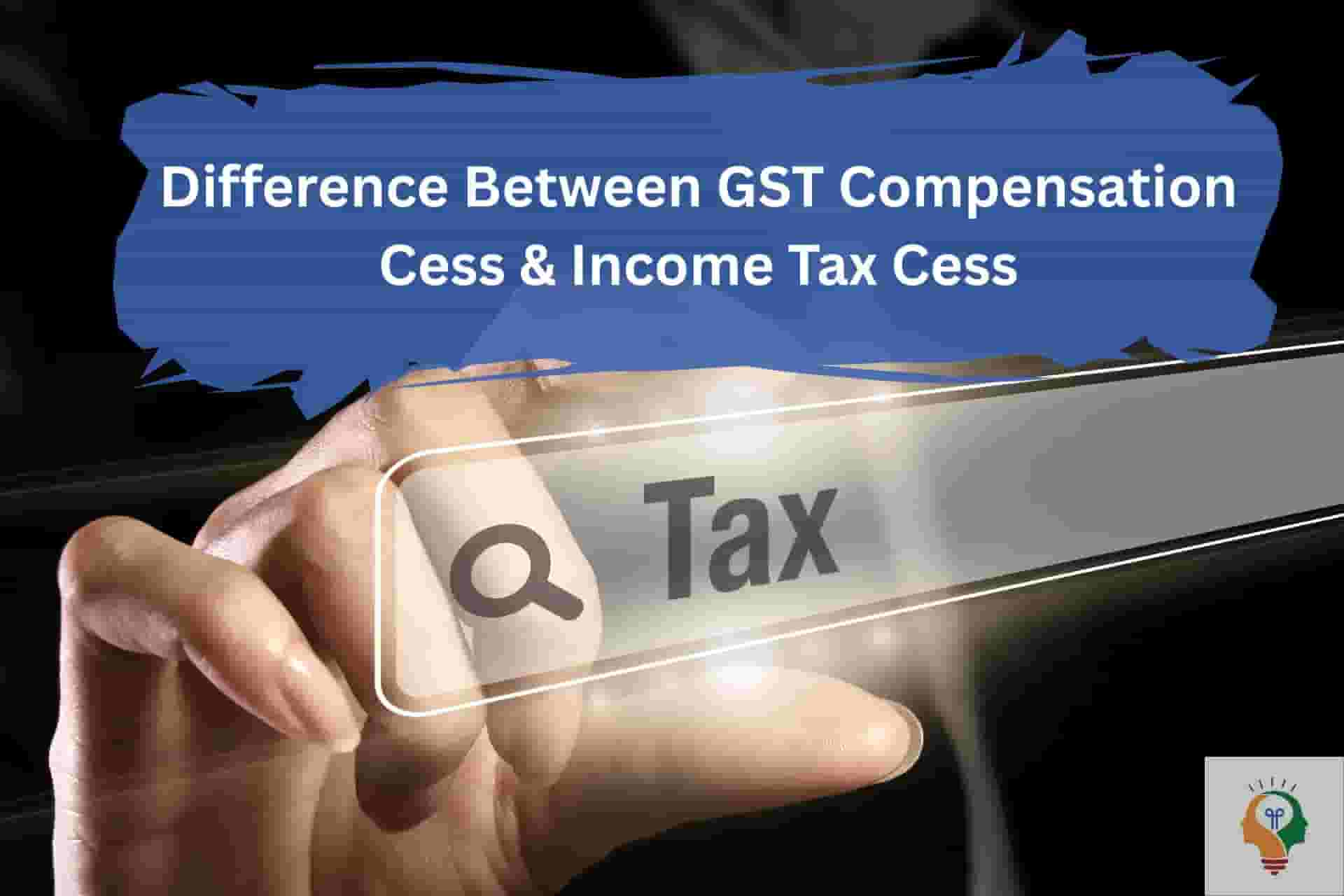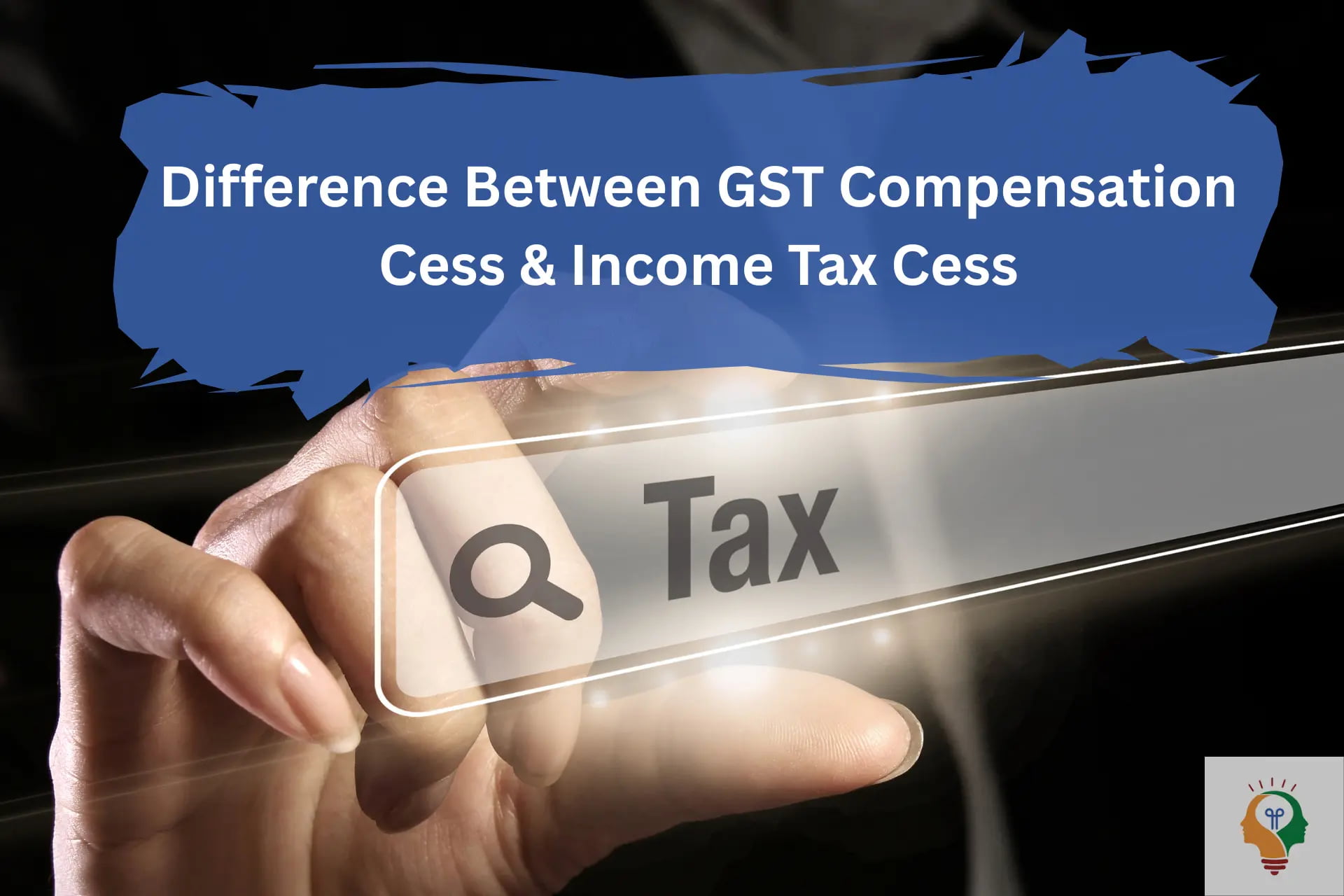Difference Between GST Compensation Cess And Income Tax Cess?
Updated: 12-10-2025 at 11:25 PM
1k


GST compensation cess and income tax cess are both forms of levies but are applied to different things. GST cess compensation is specific to certain goods, like luxury and demerit category goods. Income tax cess is an additional levy applied to specific government initiatives relating to health and education. Understanding both requires looking into the GST Compensation Cess Act, calculation methods, and their overall impact.
In this article, you will get the detailed information about the GST Compensation and its difference with compensation cess and income tax and much more.
Overview
Understanding the difference between GST compensation cess and income tax cess is essential, as both serve distinct purposes in India’s taxation system. The table below summarises the key aspects for quick reference.
| Aspect | GST Compensation Cess | Income Tax Cess |
|---|---|---|
| Purpose | To compensate manufacturing states for revenue loss due to GST implementation | To fund specific government initiatives like education and healthcare |
| Applicability | Levied on certain goods (luxury & demerit goods) under the GST Compensation Cess Act | Levied on every taxpayer including individuals, HUFs, companies, and firms |
| Examples | Luxury cars, aerated drinks, tobacco, coal | 4% cess on income tax (Education & Health) |
| Calculation | Based on taxable value + cess rate (e.g., Rs. 400 per tonne of coal) | Percentage of income tax (currently 4%) |
| Input Tax Credit | Available for businesses under input tax credit of cess under GST | Not applicable |
| Key Question | Is GST compensation cess still applicable? – Yes, for specific goods | Universally applicable to all taxpayers |
What Is The GST Compensation Cess?
GST is a consumption-based tax, so only the states where the consumption of goods and services happens are eligible for the revenue on supplies. So, states focusing on manufacturing goods will face a decrease in revenue from indirect taxes. States like Maharashtra, Tamil Nadu, Gujarat, Haryana, and Karnataka face a decrease in revenue as they are manufacturing states.
The GST compensation cess was introduced under the GST Compensation Cess Act to compensate states for revenue losses. This ensures that manufacturing states are not left at a disadvantage. But is GST compensation cess still applicable? Yes, it continues to apply to luxury and demerit goods until the revenue gap of states is addressed.
For luxury cars used for private use, 28% of GST is applicable, and GST compensation will be different for different cars based on different factors such as the car’s engine and the length of the car.
For Gasoline Vehicles:
-
Cars using LPG, CNG, and petrol, below 1200 cc and with a length of 4 m, will have 28% GST and 1% GST cess.
-
Cars using LPG, CNG, and petrol below 1200 cc and above the length of 4 m will have 28% GST and 15% GST cess.
-
Cars using LPG, CNG, and petrol above 1200 cc, irrespective of their length, will have 28% GST and 22% GST cess.
For Diesel Vehicles:
-
Cars that run on diesel and are below 1500 cc and 4 m in length will have 28% GST and 3% GST cess.
-
Cars running on diesel below 1500 cc and above 4 m in length will have 28% GST and 20% GST cess.
So, if you are planning to buy a car, understanding how to calculate cess on GST is crucial since it has a direct impact on the price.
Read More: Centre Introduces Biometric ID To Fight GST Fraud In India
What Goods Come Under CST Compensation Cess?
There are several goods that come under GST compensation. The goods that come under it are as follows:
- Aerated drinks
- Tobacco products
- Coal and lignite
- Luxury cars
GST Compensation Cess Rates
The table below highlights the key insights of the GST Compensation cess rates. Read the table below to understand it better:-
| Goods | GST Compensation Cess Rate |
|---|---|
| Luxury cars | 22% |
| Unmanufactured tobacco products (with lime tube) | 65% |
| Unmanufactured tobacco products (without lime tube) | 71% |
| Branded tobacco refuse | 61% |
| Cheroots and cigar | 21% or Rs. 4170 per thousand |
| Cigarettes containing tobacco apart from filter cigarettes, of length more than 65 mm and up to 75 mm | 5% + Rs.3668 per thousand |
| Branded ‘Hookah’ or ‘gudaku’ tobacco | 72% |
| Chewing tobacco (w/o lime tube) | 160% |
| Chewing tobacco (with lime tube) | 142% |
| Pan masala (Gutkha) containing tobacco | 204% |
| All goods, excluding pan masala containing tobacco ‘gutkha’, with brand name | 96% |
| All goods, excluding pan masala containing tobacco ‘gutkha’, not bearing a brand name | 89% |
| Coal, ovoids, briquettes, and similar solid fuels manufactured from lignite, coal, whether or not agglomerated, excluding jet, peat (including peat litter), whether or not agglomerated | Rs. 400 per tonne |
| Aerated drinks | 12% |
| Coal and lignite | Rs. 400 per ton |
| Some specific goods | Changes |
For tobacco-based products, businesses must often perform GST cess on tobacco calculation to estimate costs, using a GST compensation cess and income tax cess calculator as a reference.
How Is GST Compensation Cess Is Calculated?
How to calculate cess on GST? It is based on the value of taxable goods and services.
For example:
Mr. Akhil purchased 2 tonnes of coal worth Rs. 14,000. With a fixed cess of Rs. 400 per tonne, Rs. 800 would be levied. This is a simple GST Compensation Cess example that shows how it applies in real life.
Another GST compensation cess and income tax cess example would be when a manufacturer of tobacco pays cess on raw goods and later claims input tax credit of cess under GST for resale.
What Is Income Tax Cess?
Income tax cess is imposed for specific government initiatives like education and health. Unlike gst cess, it is not on consumption but directly on taxpayers.
Every taxpayer is liable to pay a fixed cess rate of 4%. For the education cess, the government introduced 2% to meet the needs of the government. This will help in ensuring good quality education for the poor people in India.
However, the government then realised that they needed funds to provide access to secondary and higher education as well. So, in 2007, an additional 1% cess was added to fund secondary and higher education.
But then the government faced another issue that was brought to light by Finance Minister Arun Jaitley in 2008. The government had to start various programmes to meet the educational needs of below-the-line (BPL) and rural families. The cess was then increased by another 1%, making it a total of 4%.
This levy continues annually. Like GST, one can also work out the impact through a simple gst compensation cess and income tax cess calculator.
Also Read: Clubbing Of Income Under Section 64 Of The Income Tax Act Rule & Guidelines
Who Is Eligible For Income Tax Cess?
All taxpayers—individuals, HUFs, companies, and firms—are liable. Even if you’re using a GST compensation cess and income tax cess example, remember that, unlike cess on GST (applied on goods), income tax cess is universal.
Why Were Both Cess Introduced?
The GST compensation cess was introduced to ensure financial stability in manufacturing states that face a loss due to the implementation of GST.
While the GST Compensation Cess Act is revenue protection-driven, the income tax cess is socially driven. Both are tools for nation-building.
Read More: Income Tax On Credit Card Transactions: Strategies To Avoid A Tax Notice
Conclusion
While both GST compensation cess and income tax cess play important roles in India’s financial structure, they serve very different objectives. GST Compensation Cess example cases show how it supports states, while income tax cess ensures better education and healthcare.
So, whether you’re checking the GST Cess rate list, running a gst compensation cess and income tax cess calculator, or learning how to calculate cess on GST, understanding the difference is key. Stay informed with Jaagruk Bharat for the latest on IRDA guidelines, gst cess, cess on GST, and more government policies.
You can also reach out to us via our community page if you have any questions.
Frequently Asked Questions
0
0
1k
0
0
1k Views
0
No comments available





Our Company
Home
About
T&C
Privacy Policy
Eula
Disclaimer Policy
Code of Ethics
Contact Us
Cancellation & Refund Policy
Categories
Women
Insurance
Finance
Tax
Travel
Transport & Infrastructure
Food
Entertainment
Communication
Government ID Cards
E-commerce
Traffic guidelines
Miscellaneous
Housing and Sanitation
Sports
Startup
Environment and Safety
Education
Agriculture
Social cause
Employment
Disclaimer: Jaagruk Bharat is a private organization offering support for documentation and government scheme access. We are not affiliated with any government body. Official services are available on respective government portals. Our goal is to make processes easier and more accessible for citizens.
All Copyrights are reserved by Jaagruk Bharat